Property where I hunt was select cut at beginning of October. Many islands of treetops scattered around. My goal is to connect several through use of hinging some smaller trees between them so that it creates more predictable travel pattern. Not sure I am going to be doing much more hunting this year, is it too early to start hinging this winter?


You are using an out of date browser. It may not display this or other websites correctly.
You should upgrade or use an alternative browser.
You should upgrade or use an alternative browser.
dbltree
Super Moderator
Property where I hunt was select cut at beginning of October. Many islands of treetops scattered around. My goal is to connect several through use of hinging some smaller trees between them so that it creates more predictable travel pattern. Not sure I am going to be doing much more hunting this year, is it too early to start hinging this winter?
No...in fact November is even better then December because temps are not so cold that trees are frozen and snap when they fall...:way:
dbltree
Super Moderator
December 14th, 2011
Timber Edgefeathering
Typically edge feathering is falling trees along the edge but it can also be an area from 50-100 yards into the timber depending on the situation. In this case there are already red cedars along extreme edge, a good thing of course but deer laying inside them could still see under them so I hinged trees immediate behind the cedars and at the same time worked on closing multiple runways down to one.
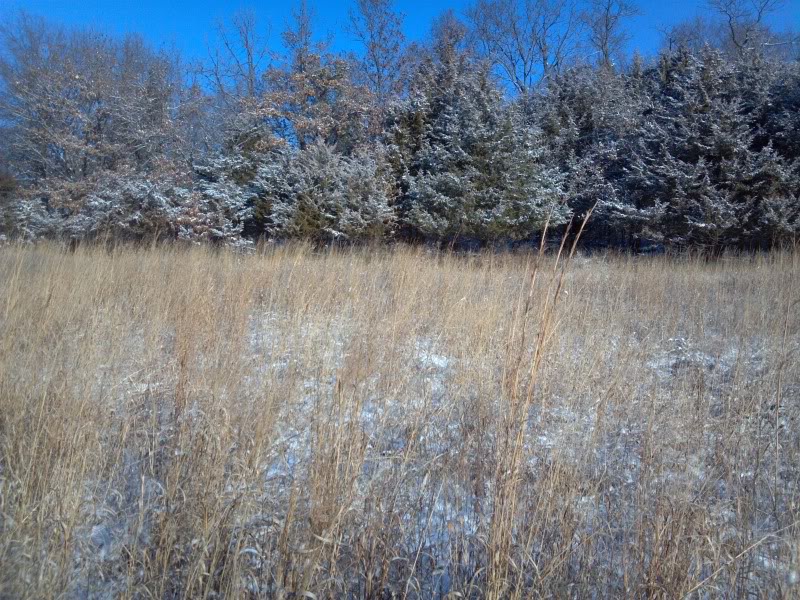
A look from the back side of the cedars

Deer were cutting across an inside corner but I blocked those runways off forcing them to stay in the timber and passing with in 25 yards of the owners stand.
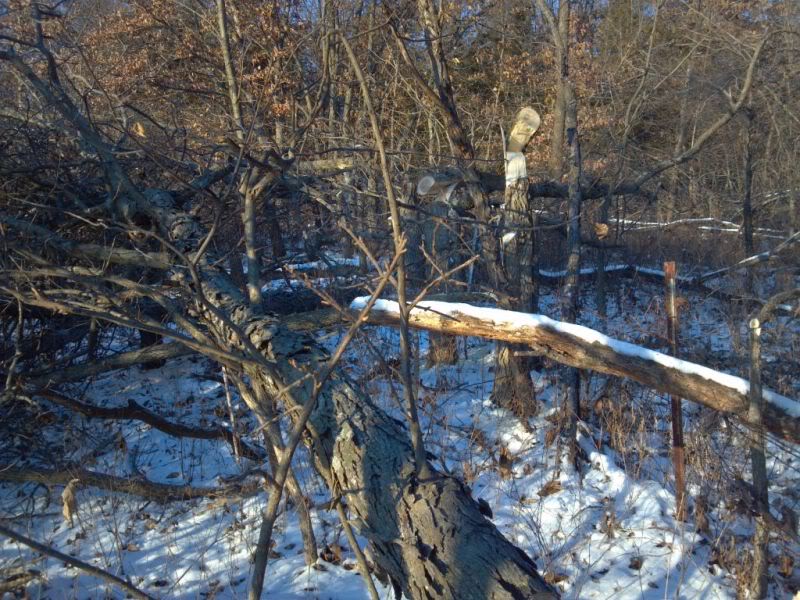
the trees are hinged high enough to create the greatest blocking screening effect
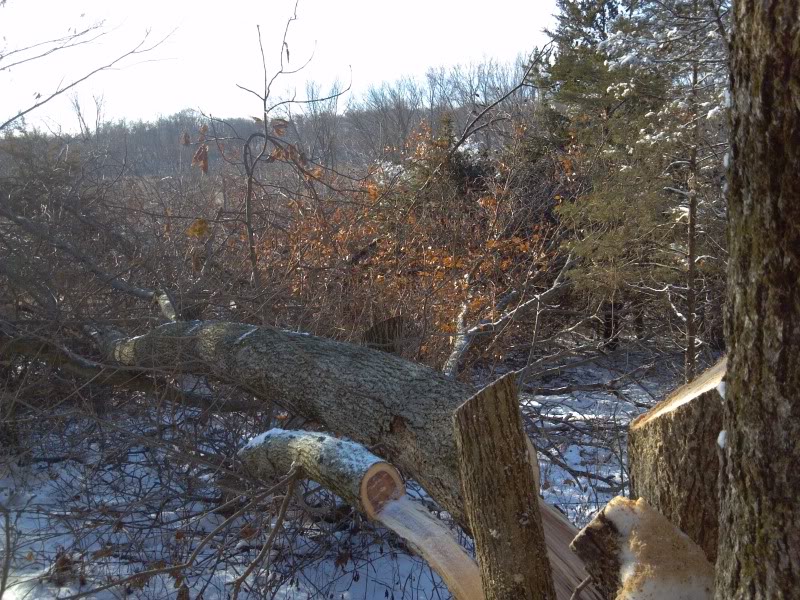
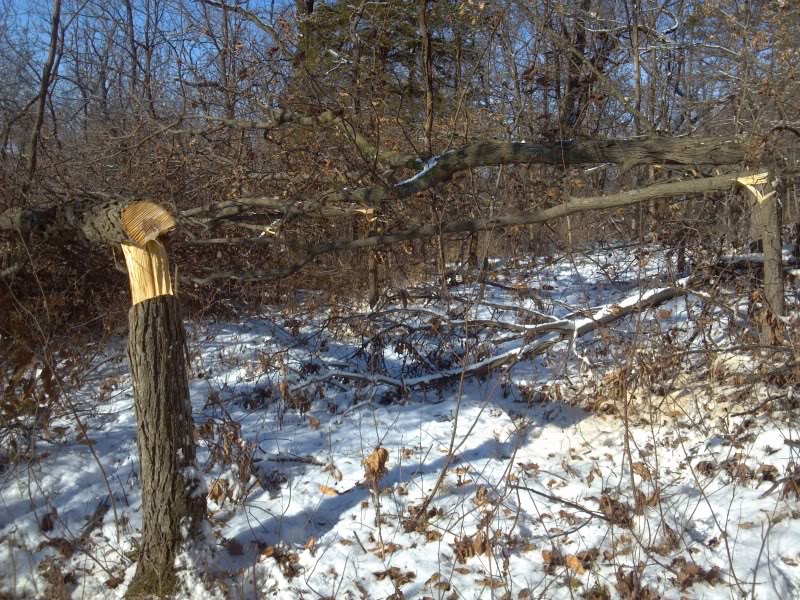
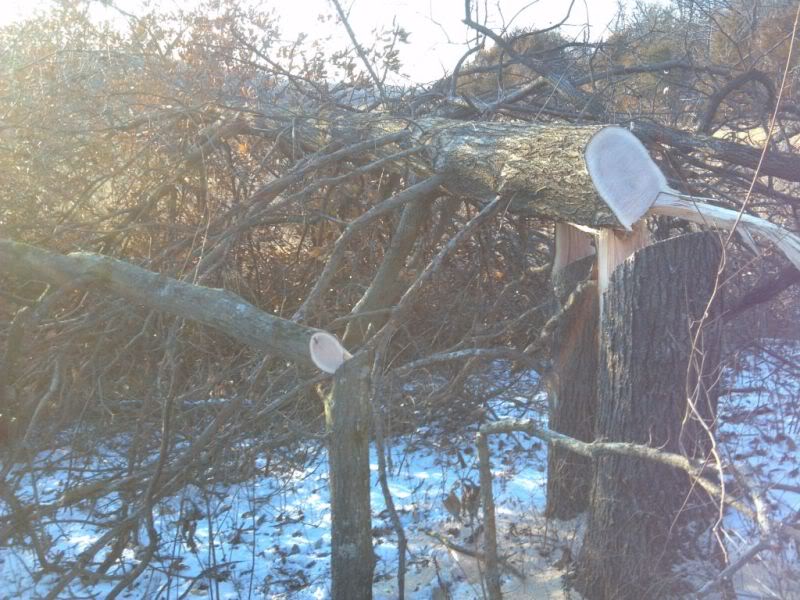
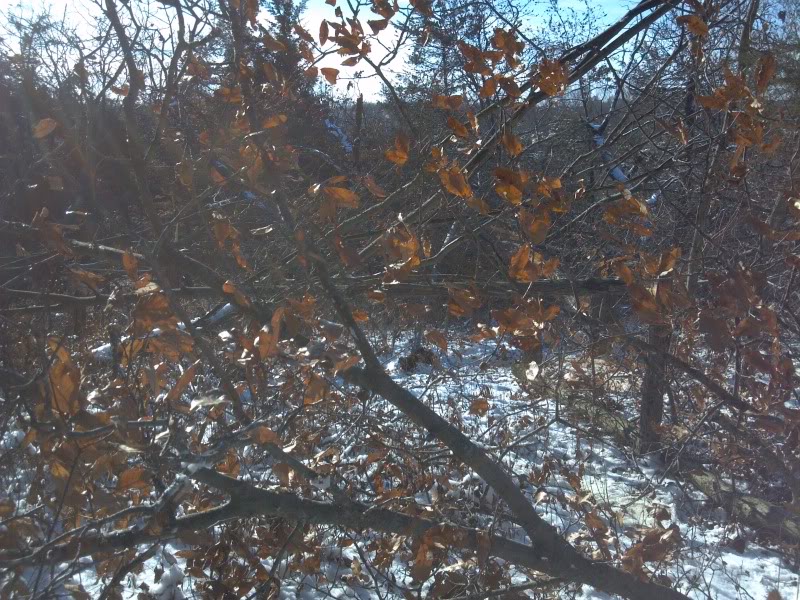
but even if some break off (usually honey locust) they still serve to create a massive block and screen along the edge
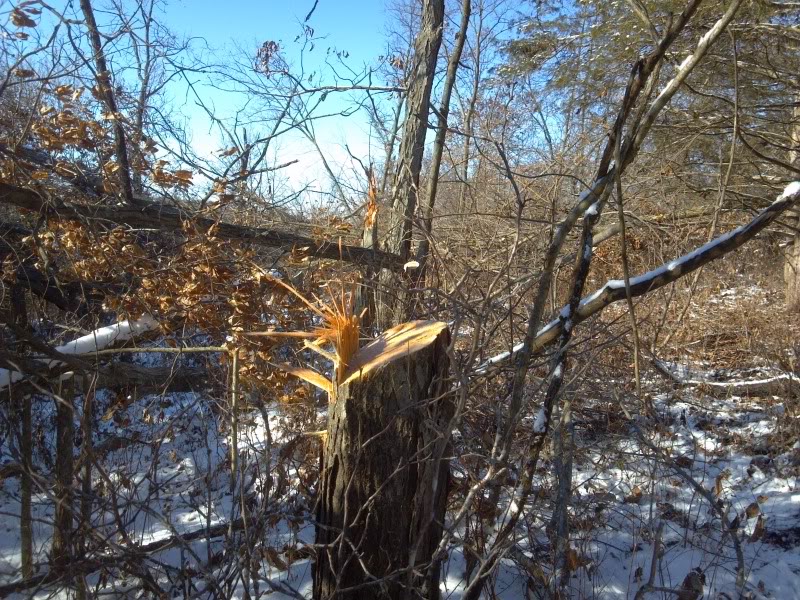
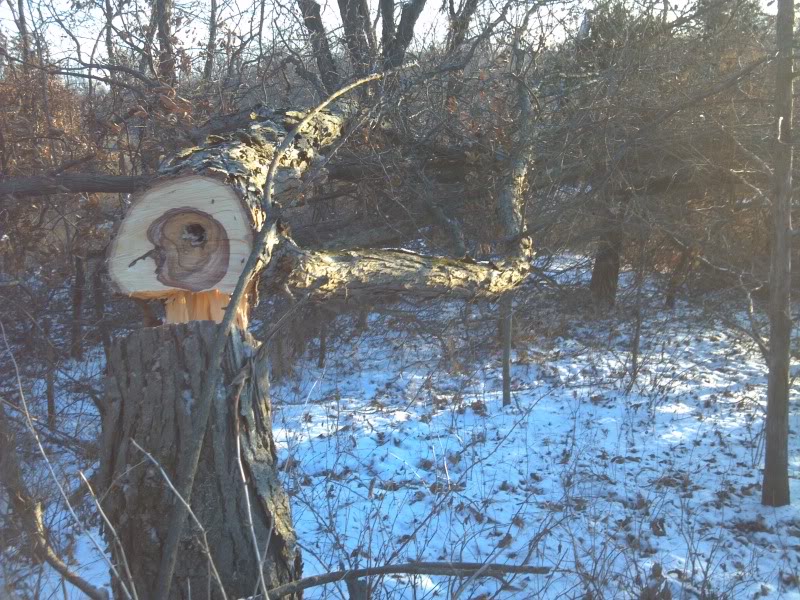
Where possible I filled in holes by falling trees into the opening

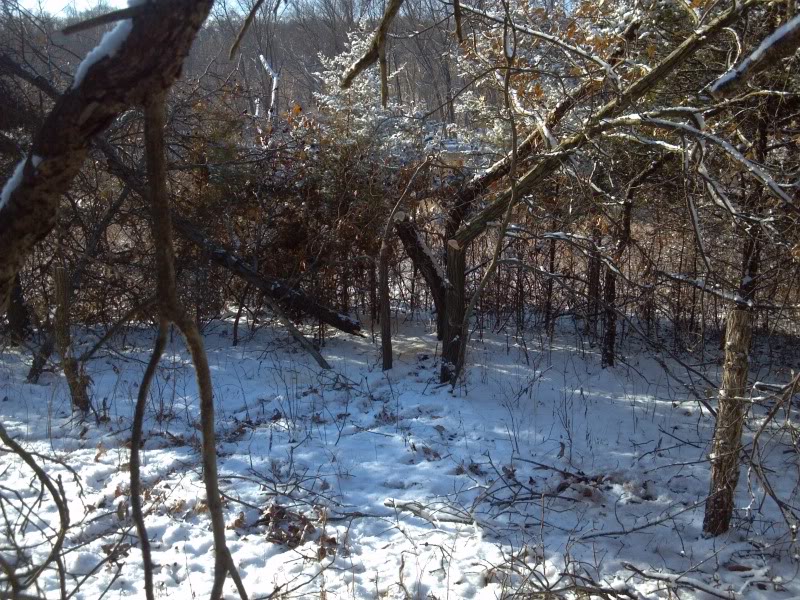

Reducing canopy will allow sunlight in to encourage red cedar regeneration along with an explosion of new shrubby browse and screening plants such as blackberries

I used the natural existing runway that traveled along the back side of the cedars and used care not to fall trees into it and if I did, I cut an opening to keep the runway open.
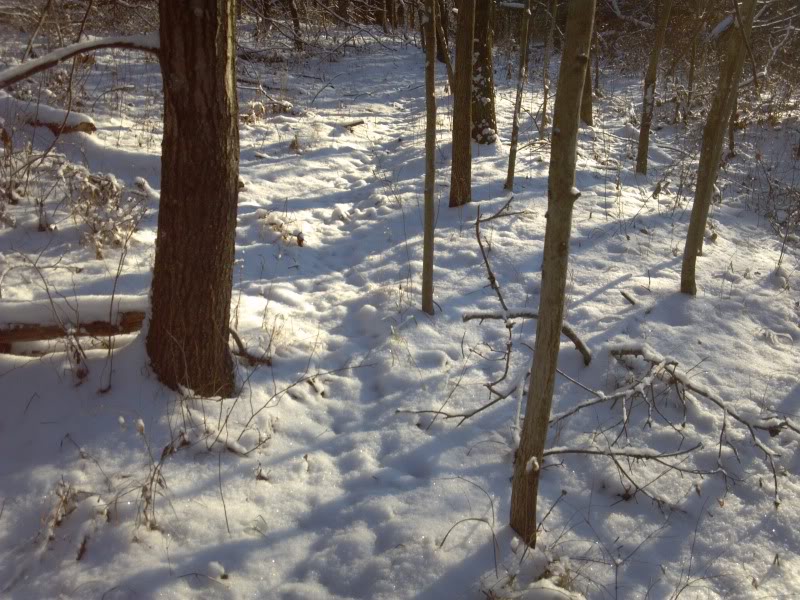
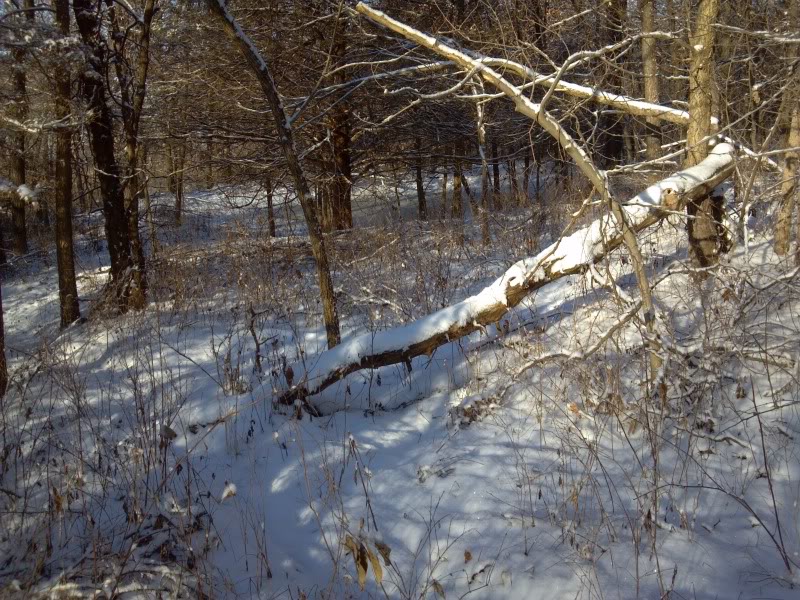
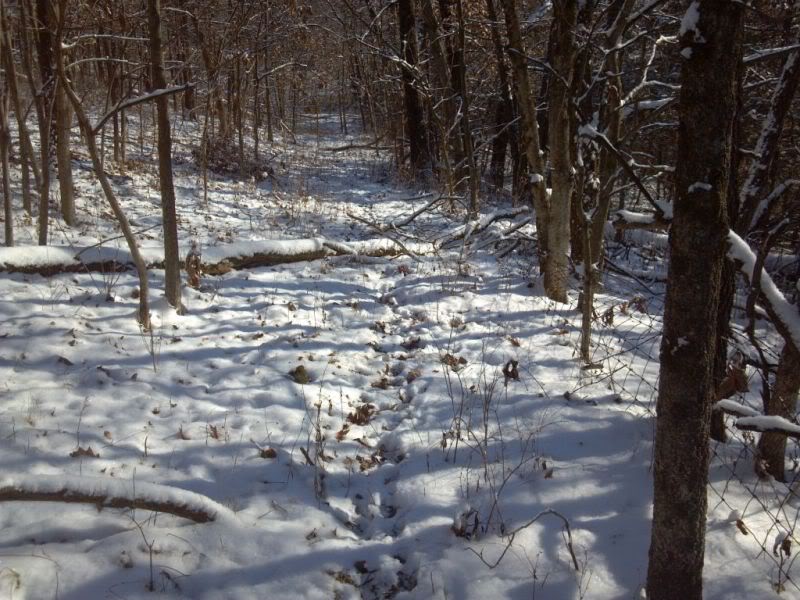
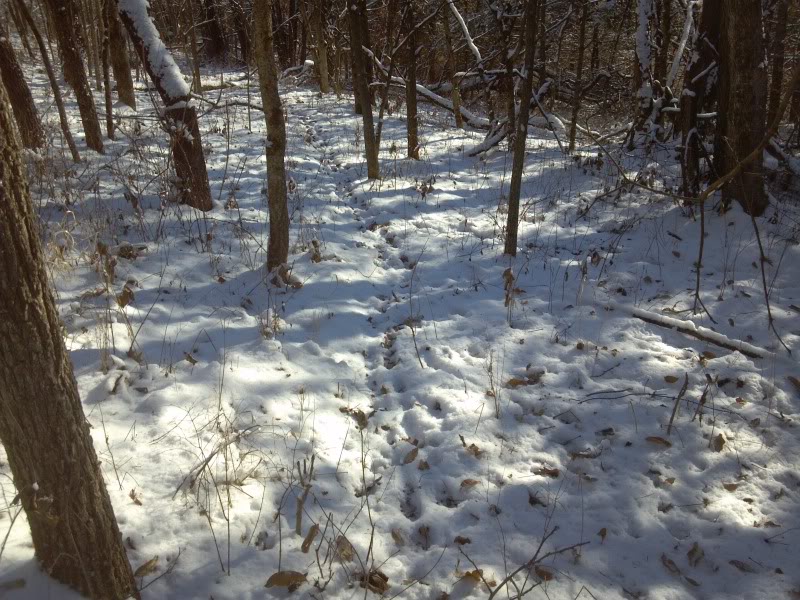
The red cedars already provide some great screening but the EF work will create an even thicker, denser screen to both funnel deer (keep them from entering the field at random points thru the cedars) and provide deer with a greater sense of security behind the mass of hinged trees,
By going all the way around the timber we will eventually have only a couple entrance/exit runways for more accurate cam surveys along with high percentage hunting stands....
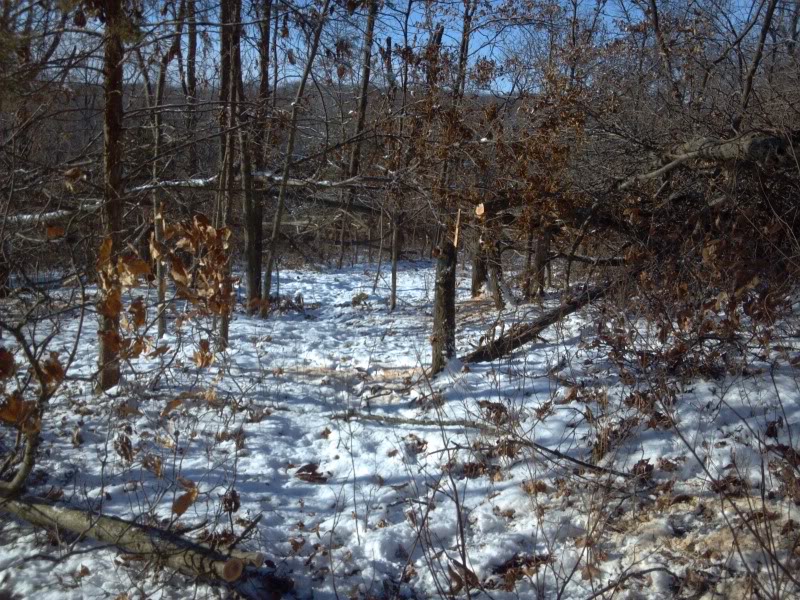
Timber Edgefeathering
Typically edge feathering is falling trees along the edge but it can also be an area from 50-100 yards into the timber depending on the situation. In this case there are already red cedars along extreme edge, a good thing of course but deer laying inside them could still see under them so I hinged trees immediate behind the cedars and at the same time worked on closing multiple runways down to one.

A look from the back side of the cedars

Deer were cutting across an inside corner but I blocked those runways off forcing them to stay in the timber and passing with in 25 yards of the owners stand.

the trees are hinged high enough to create the greatest blocking screening effect




but even if some break off (usually honey locust) they still serve to create a massive block and screen along the edge


Where possible I filled in holes by falling trees into the opening



Reducing canopy will allow sunlight in to encourage red cedar regeneration along with an explosion of new shrubby browse and screening plants such as blackberries

I used the natural existing runway that traveled along the back side of the cedars and used care not to fall trees into it and if I did, I cut an opening to keep the runway open.




The red cedars already provide some great screening but the EF work will create an even thicker, denser screen to both funnel deer (keep them from entering the field at random points thru the cedars) and provide deer with a greater sense of security behind the mass of hinged trees,
By going all the way around the timber we will eventually have only a couple entrance/exit runways for more accurate cam surveys along with high percentage hunting stands....

Hey Dbltree, really enjoy your posts on various forums. I wanna pick your brain before actually attempt this. I have a situation where deer are utilizing a tall grass field behind a neighbor's home to the south of our property as a bedding area. They enter a crop field through a thin fence line. There is not a suitable tree for a stand. Any approach to that fence line would spook deer as they are in and around it at all hours.
I would like to feather that fence line in an attempt to force deer to travel east down the fence line and closer to an established stand sight.
Should I feather the fence line towards the bedding cover, towards the field edge or feather it parallel with the existing fence line?
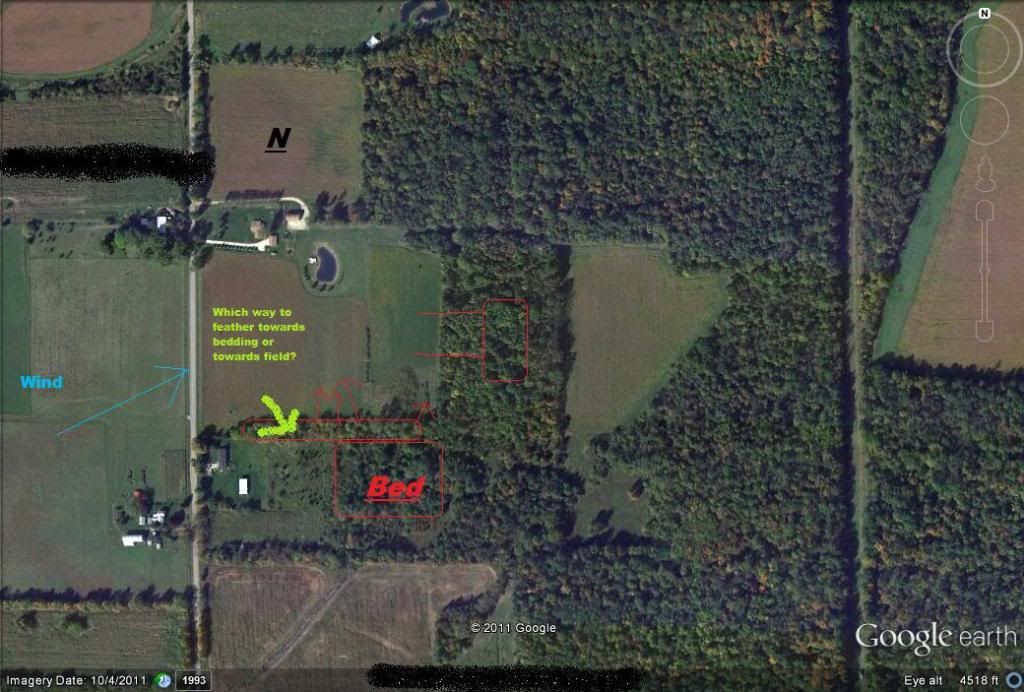
Looking forward to your input.
I would like to feather that fence line in an attempt to force deer to travel east down the fence line and closer to an established stand sight.
Should I feather the fence line towards the bedding cover, towards the field edge or feather it parallel with the existing fence line?

Looking forward to your input.
dbltree
Super Moderator
Should I feather the fence line towards the bedding cover, towards the field edge or feather it parallel with the existing fence line?
I assume your question is in regards to "direction" of falling the trees? Along the edge there is only one way they are going to fall! They will be all leaning out into the field for sunlight, so hinge them as you see in the pictures so that they fall naturally into the field perpendicular to the fence line. Then use a tractor and loader (or skid steer) and swing them around parallel to the fence to create a blocking and screening effect. The trees shown in my pictures have not been moved yet but I will push all of them parallel with the edge when I am done cutting.
dbltree
Super Moderator
December 19th, 2011
It's always interesting to visit hinged areas several years later and note the difference in cover. These areas from several farms done by other people where I am now doing more follow up work
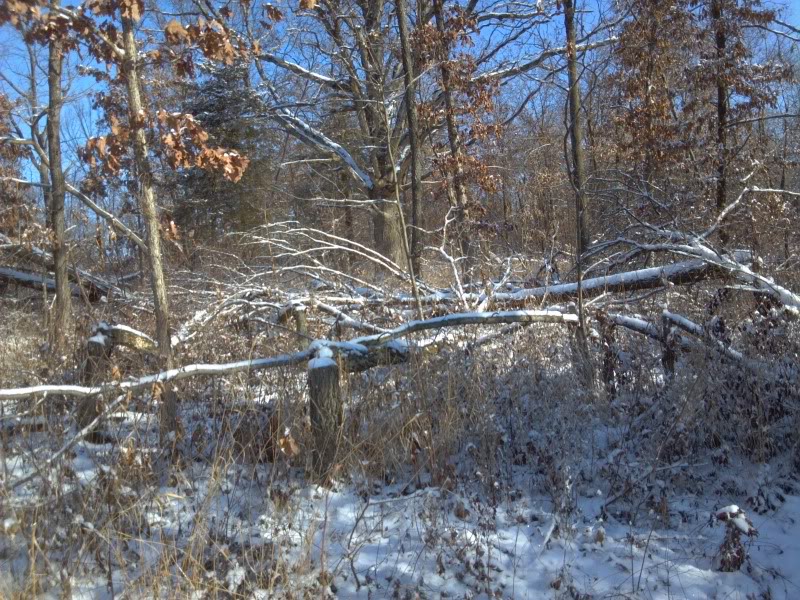
Compared to the open timber here previously, the are is now growing thick with brushy cover
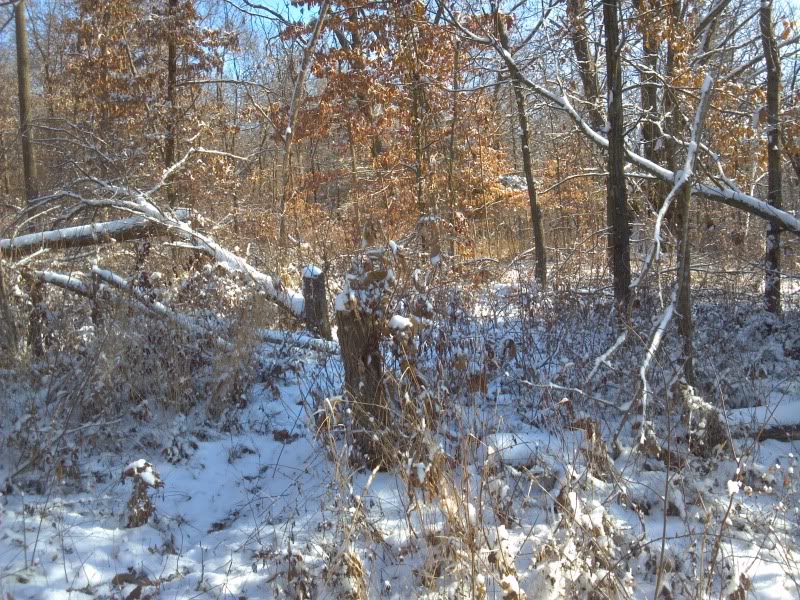
and that of course attracts deer like a magnet
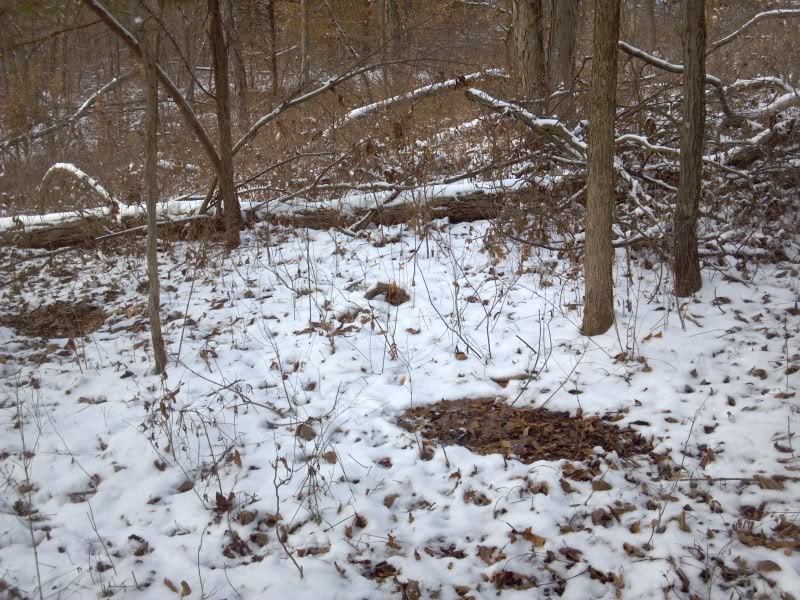
Hinged area re-growth can be phenomenal, even if the hinged trees do not survive, the simple act of opening up canopy will then cause an explosion of re-growth.
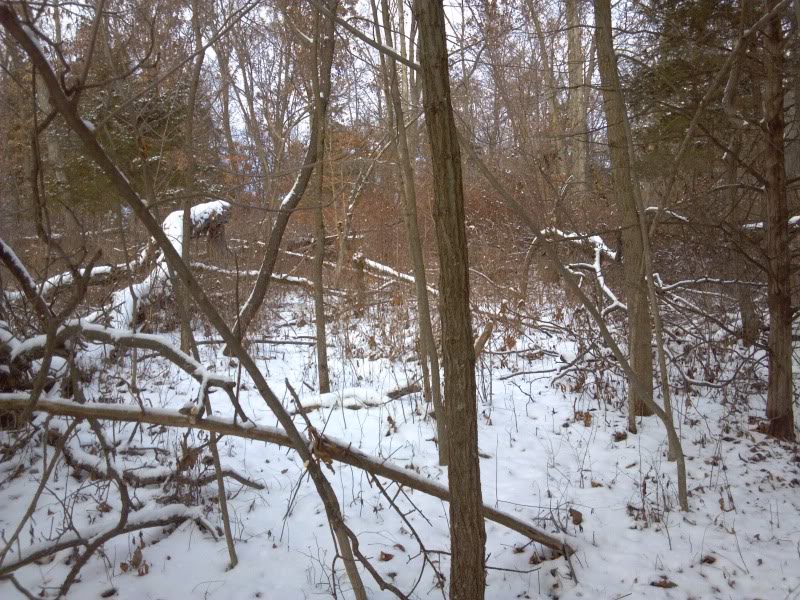
Tree that remain alive become a "living brushpile" and increase both screening and browse
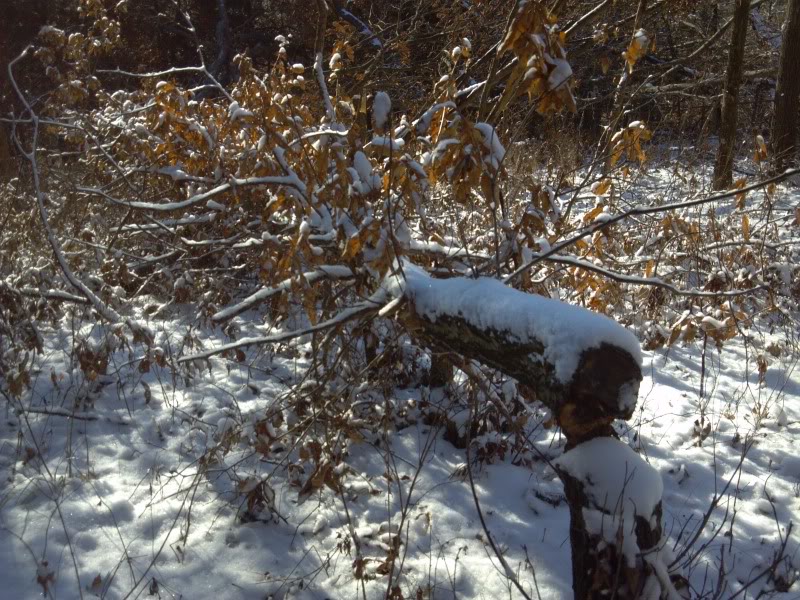
When hinging be sure to make the hinge waist to chest high more like the trees on the left then the one in the foreground
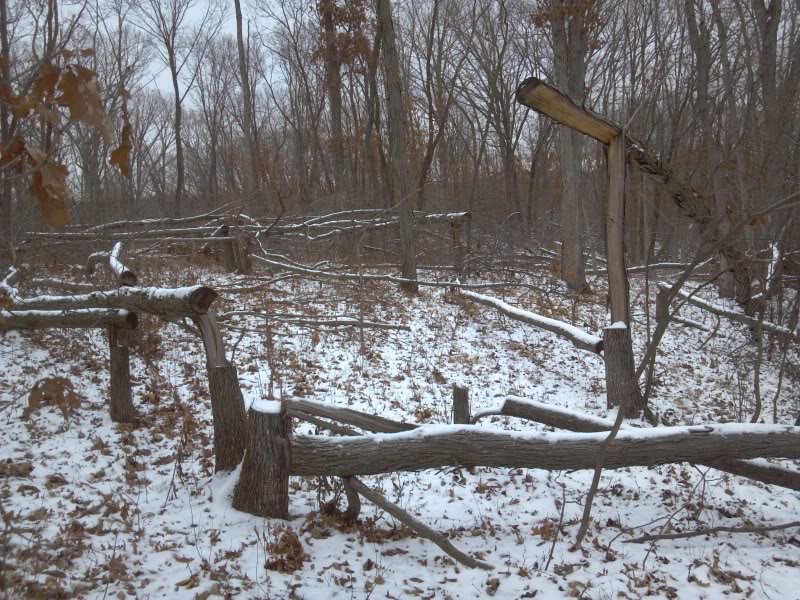
Trees cut higher are more likely to have beds under them although they are attracted to almost any ground clutter that they can back up against
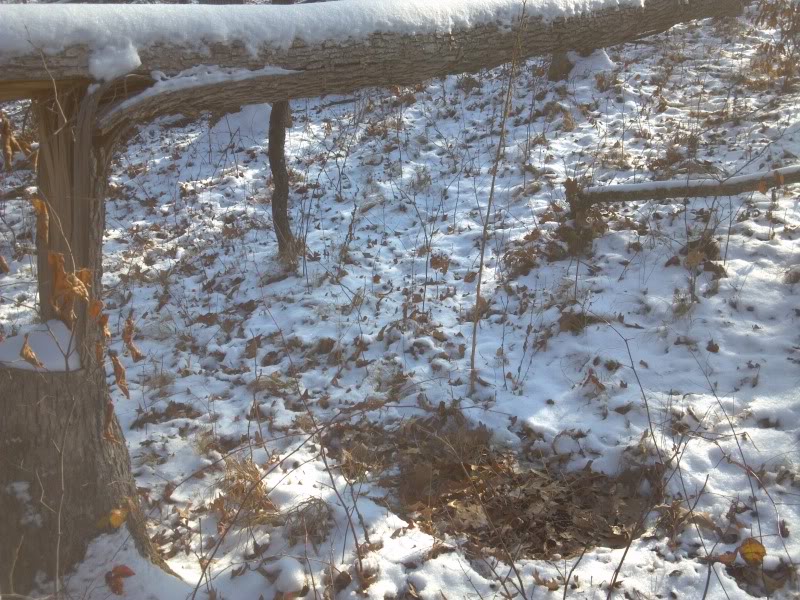
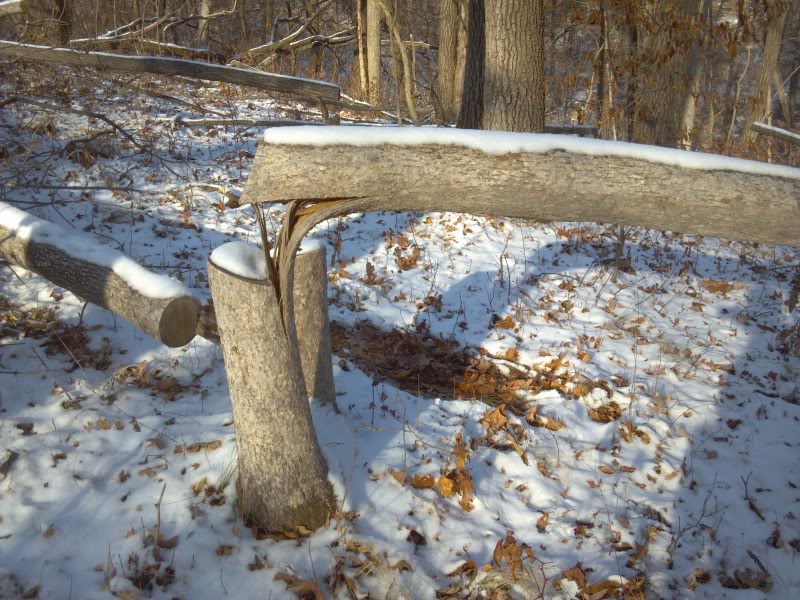
Here is a sample of deer using ground clutter versus overhead cover...the point is to get trees on the ground!
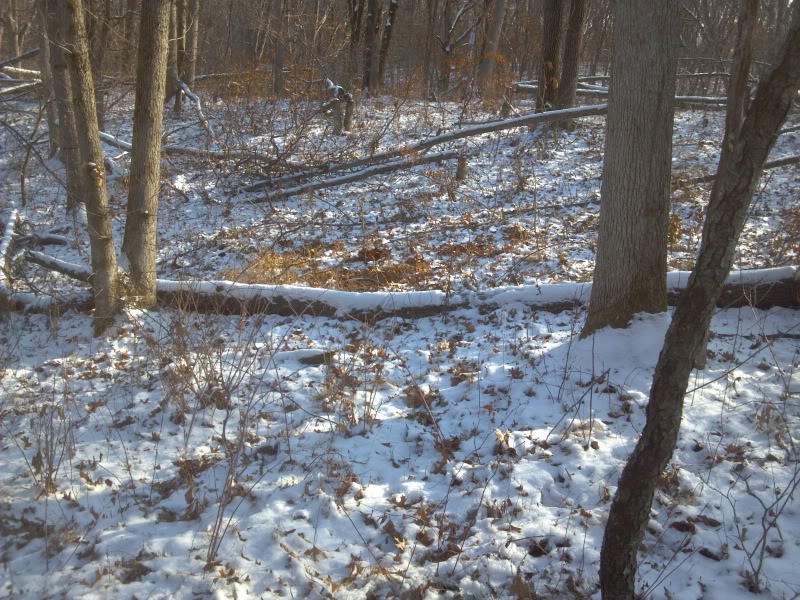
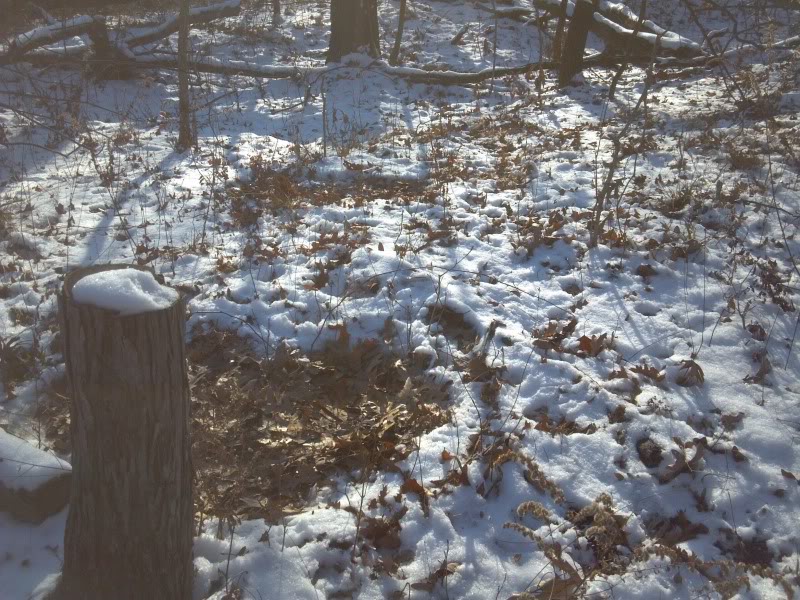
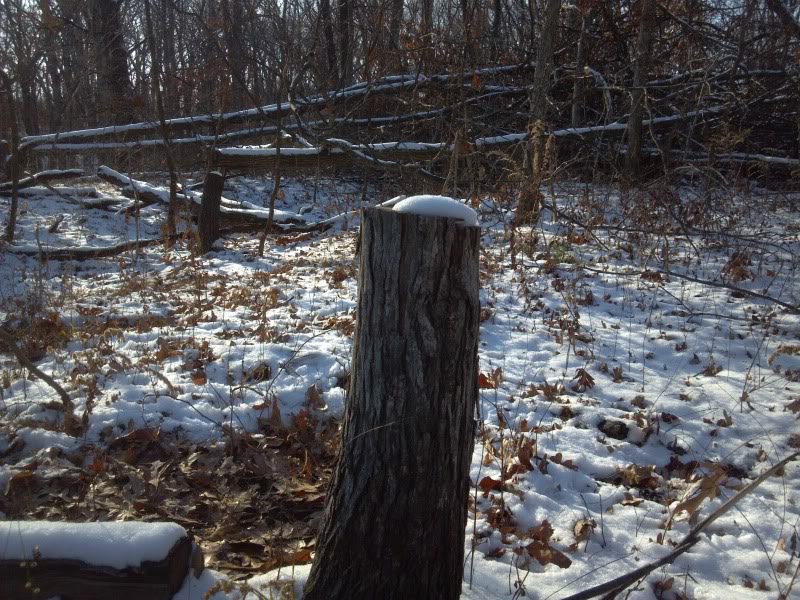
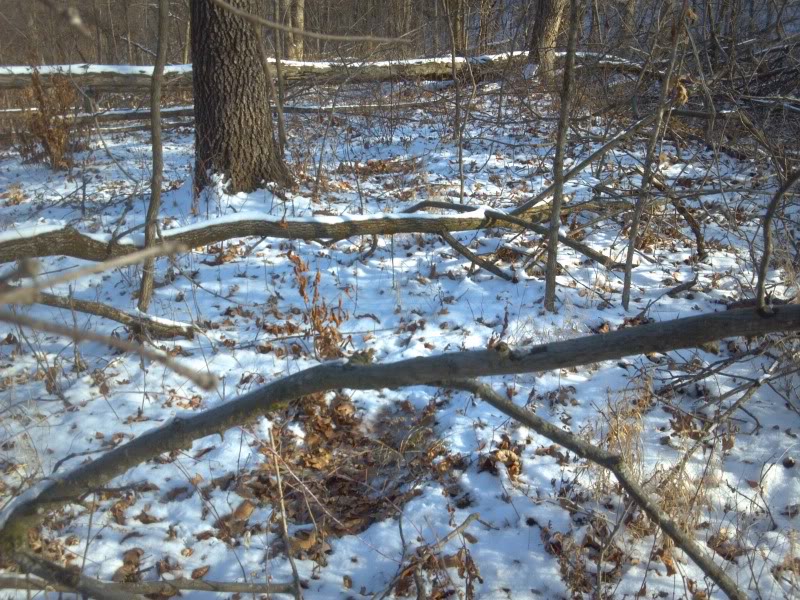
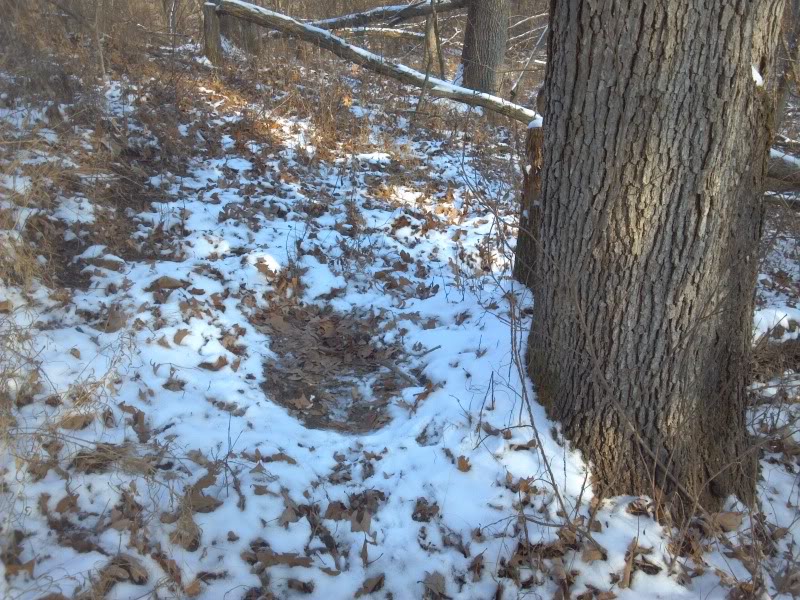
Note the stark difference the hinged trees in the foreground make compared to the wide open "park like" area in the back ground.
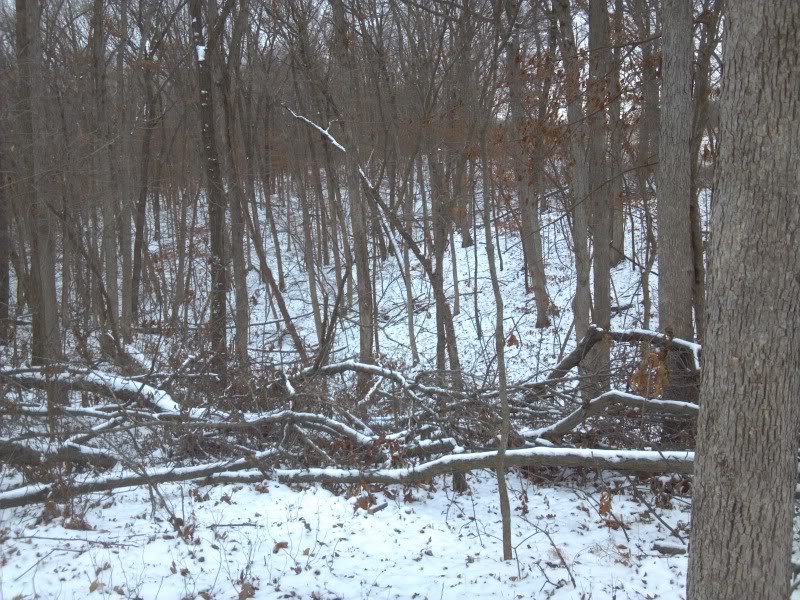
Note here the oak regeneration that accompanies the removal of canopy, assuming of course that there are oak seed trees near by.
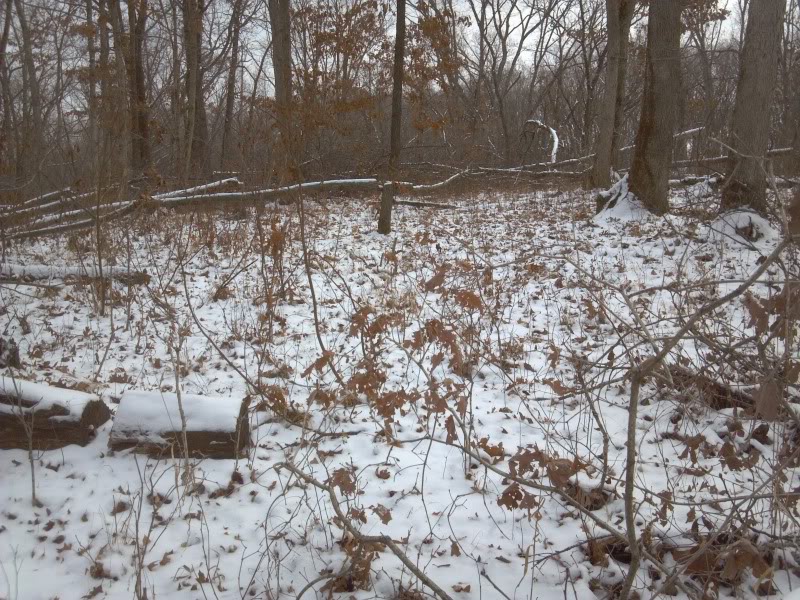
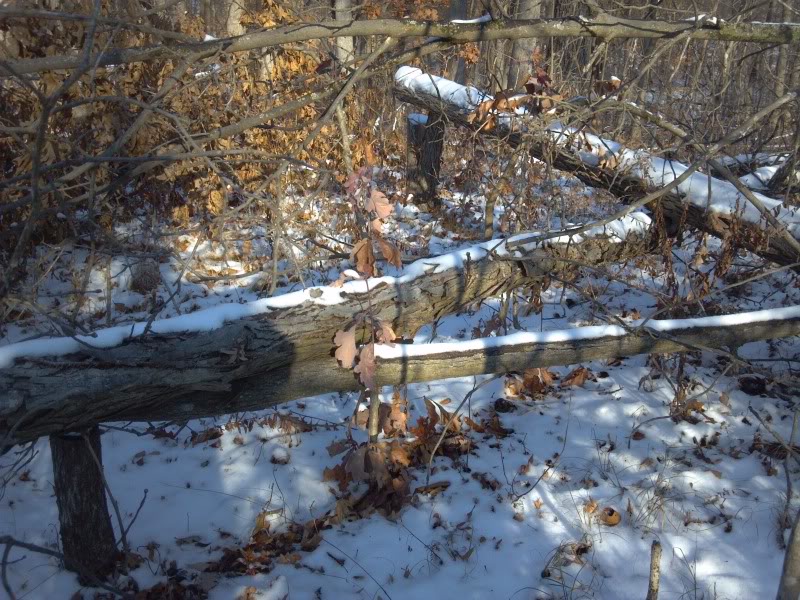
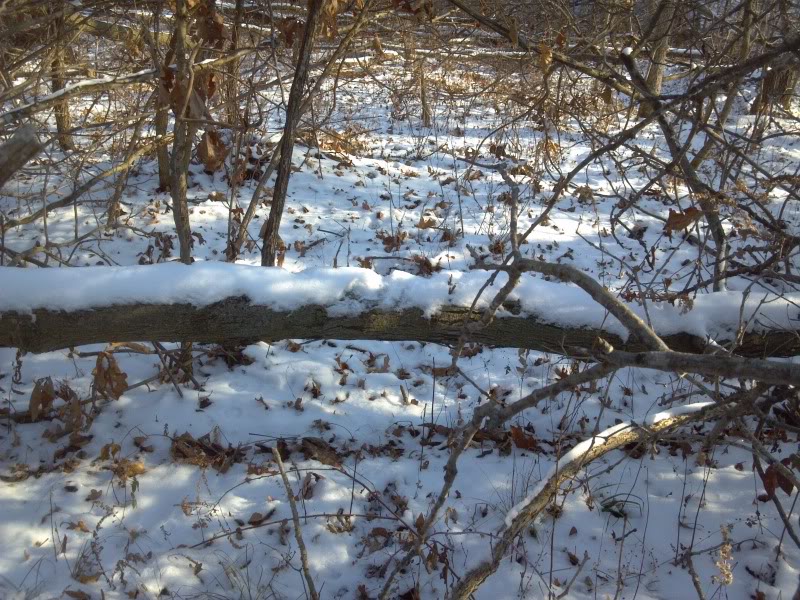
Hinging trees creates not only much needed bedding but ever important browse as well
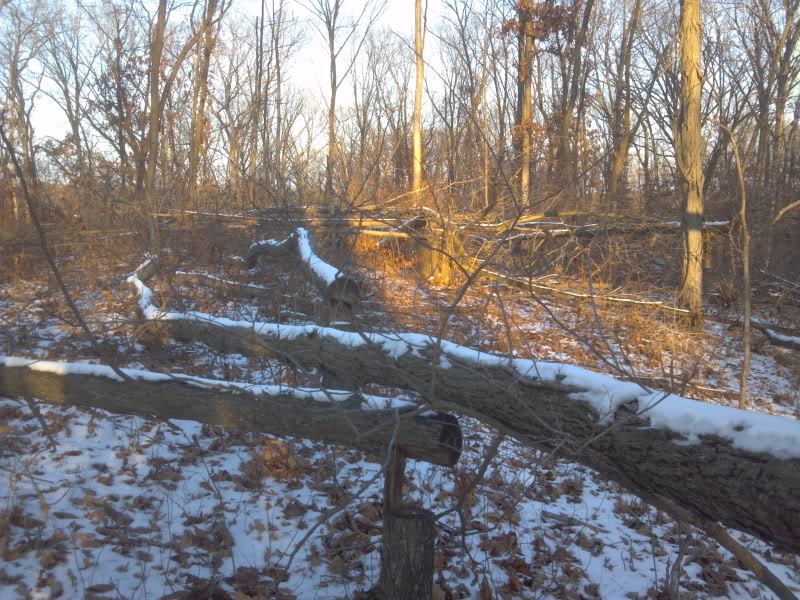
There is neither food nor cover in ope timber like this and the runway shown is coming from a hinged area and leading to a food source.
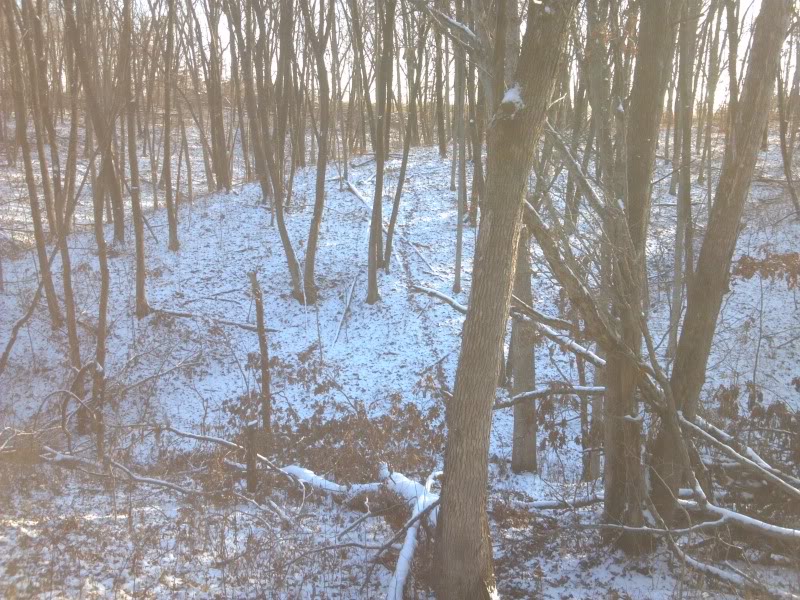
You can radically change the quality of your habitat and hold deer like never before using hinging as a tool
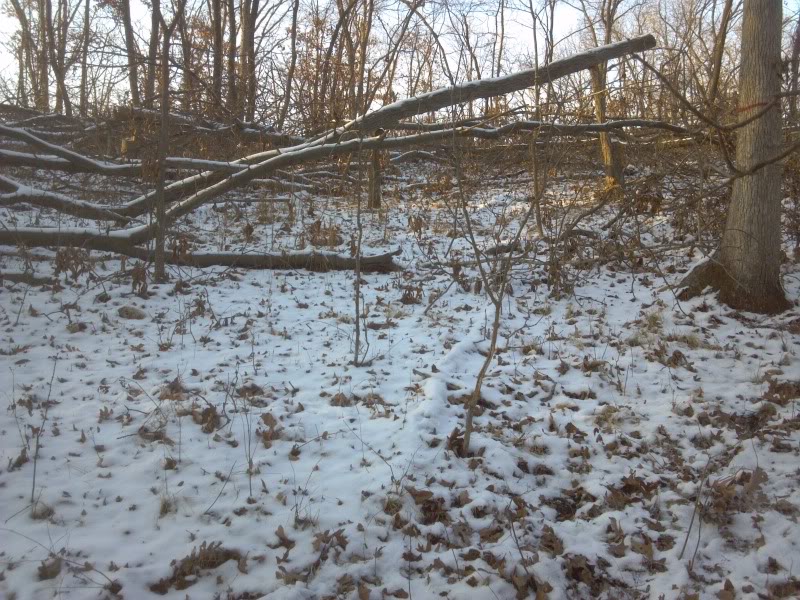
You caution however not to destroy good crop trees so always begin by working with your forester, identifying and marking crop trees and then releasing them by girdling large trees and hinging smaller trees.
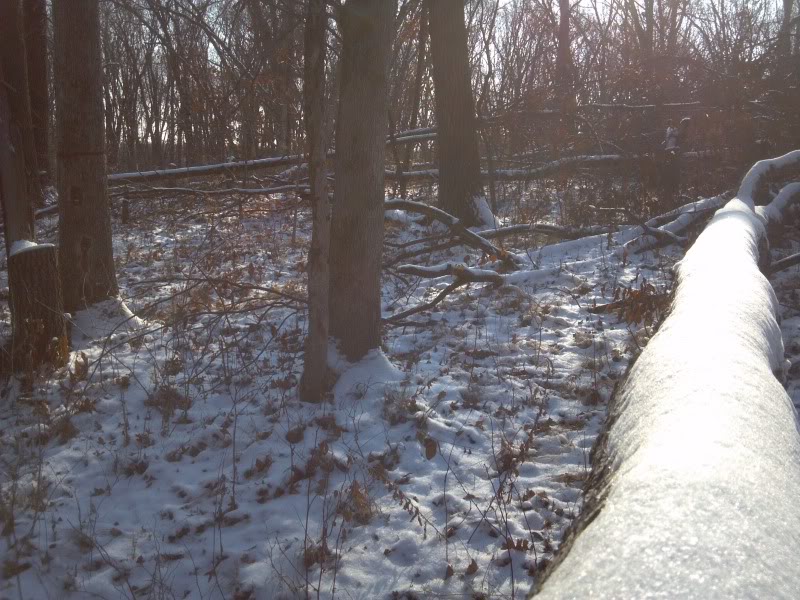
I urge you to read through the information on Timber Stand Improvement first
Timber Stand Improvement
Then build better habitat with your chainsaw and some sweat equity... :way:
It's always interesting to visit hinged areas several years later and note the difference in cover. These areas from several farms done by other people where I am now doing more follow up work

Compared to the open timber here previously, the are is now growing thick with brushy cover

and that of course attracts deer like a magnet

Hinged area re-growth can be phenomenal, even if the hinged trees do not survive, the simple act of opening up canopy will then cause an explosion of re-growth.

Tree that remain alive become a "living brushpile" and increase both screening and browse

When hinging be sure to make the hinge waist to chest high more like the trees on the left then the one in the foreground

Trees cut higher are more likely to have beds under them although they are attracted to almost any ground clutter that they can back up against


Here is a sample of deer using ground clutter versus overhead cover...the point is to get trees on the ground!





Note the stark difference the hinged trees in the foreground make compared to the wide open "park like" area in the back ground.

Note here the oak regeneration that accompanies the removal of canopy, assuming of course that there are oak seed trees near by.



Hinging trees creates not only much needed bedding but ever important browse as well

There is neither food nor cover in ope timber like this and the runway shown is coming from a hinged area and leading to a food source.

You can radically change the quality of your habitat and hold deer like never before using hinging as a tool

You caution however not to destroy good crop trees so always begin by working with your forester, identifying and marking crop trees and then releasing them by girdling large trees and hinging smaller trees.

I urge you to read through the information on Timber Stand Improvement first
Timber Stand Improvement
Then build better habitat with your chainsaw and some sweat equity... :way:
dbltree
Super Moderator
This is an example of "feathering" the trees starting with the smaller trees at the outer edge and then moving backwards falling taller/larger trees on top of the small ones to block and screen the edge. The right side is an example of an inside corner and how I used edge feathering to block and screen the sides and prevent deer from cutting across the corner. Hinge cut area in the exterior cause traveling deer to skirt the edges (such as a rutting buck) and thus funnel them by the stand.
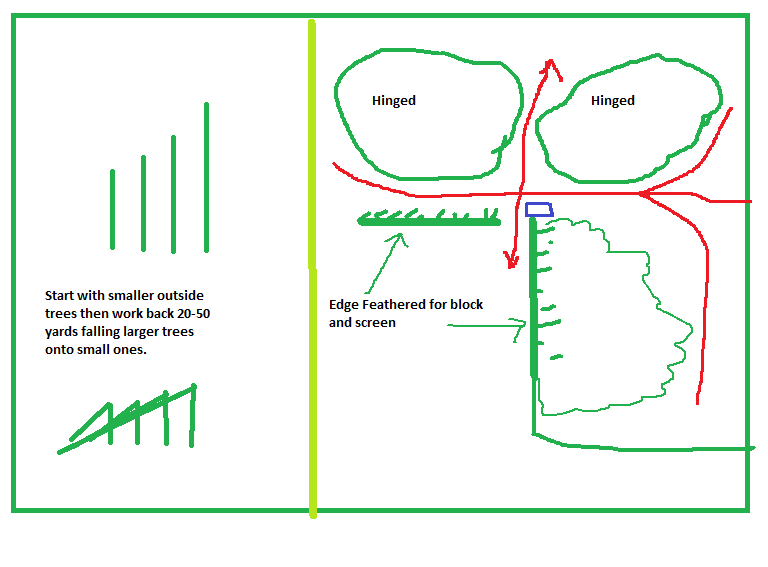
This is an example of a field I EF and left two openings for trail cam surveys as well as one near another inside corner where a natural steep draw pinches down deer and forces them near the corner. Rutting bucks should be hunted in the interior of the timber rather then the edge where they feel comfortable in daylight hours and runways that connect bedding areas and run parallel to feeding ares such as this are high percentage spots.
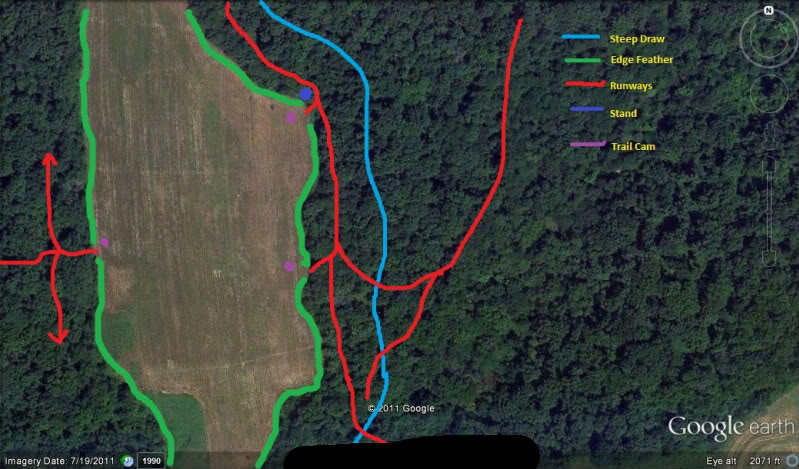
Note that while the stand is in the timber it is not far in this case and no bedding is near by allowing the hunter to slip in and out with the least disturbance. The fact that there is a draw behind it means deer are not laying on a ridge watching the hunter enter and exit...

This is an example of a field I EF and left two openings for trail cam surveys as well as one near another inside corner where a natural steep draw pinches down deer and forces them near the corner. Rutting bucks should be hunted in the interior of the timber rather then the edge where they feel comfortable in daylight hours and runways that connect bedding areas and run parallel to feeding ares such as this are high percentage spots.

Note that while the stand is in the timber it is not far in this case and no bedding is near by allowing the hunter to slip in and out with the least disturbance. The fact that there is a draw behind it means deer are not laying on a ridge watching the hunter enter and exit...
treerat
Active Member
This is a picture taken from the bow stand in November, of an 11-month old edge feather job. As you can tell, there were very few desirable species in the area based on the number of large trees left. However, there are tons of young 6" oaks and a nice aspen stand taking hold in this area. I have some work to do to clear trails that were blocked with fallen trees and create a few strategic access points to the field.

dbltree
Super Moderator
Blocking with Edge Feathering
I edge feathered timber a while back but mild west weather kept me from pushing the trees around with the tractor. I always seed around the perimeter with white clover in the fall on new feeding areas and I didn't want to tear up the newly established seeding. A couple days down in the teens allowed me to work on the frozen soil however and I started pushing the trees around parallel with the field edge to both screen and block off multiple runways.
Before

After
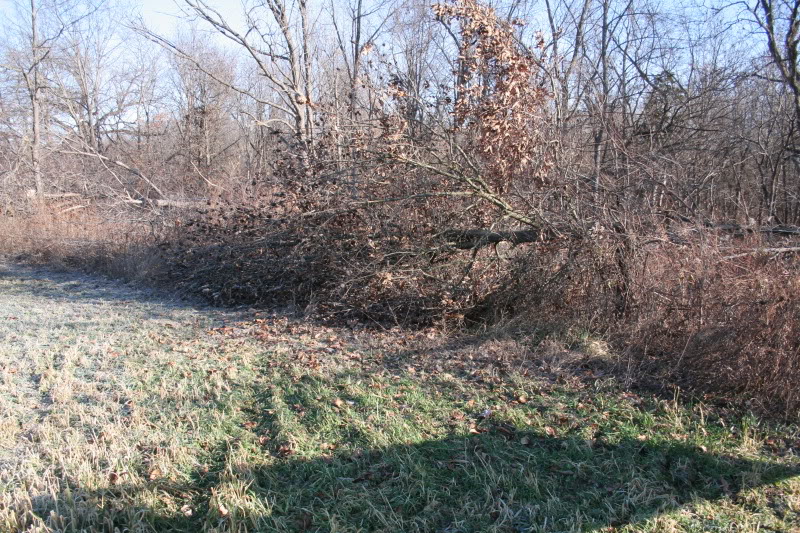
Before (note runway)
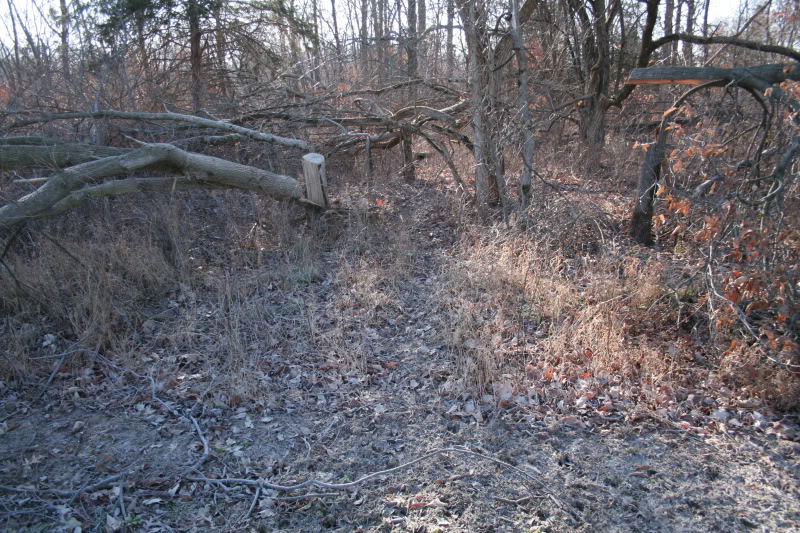
After...runway blocked with a wall of tree and brush
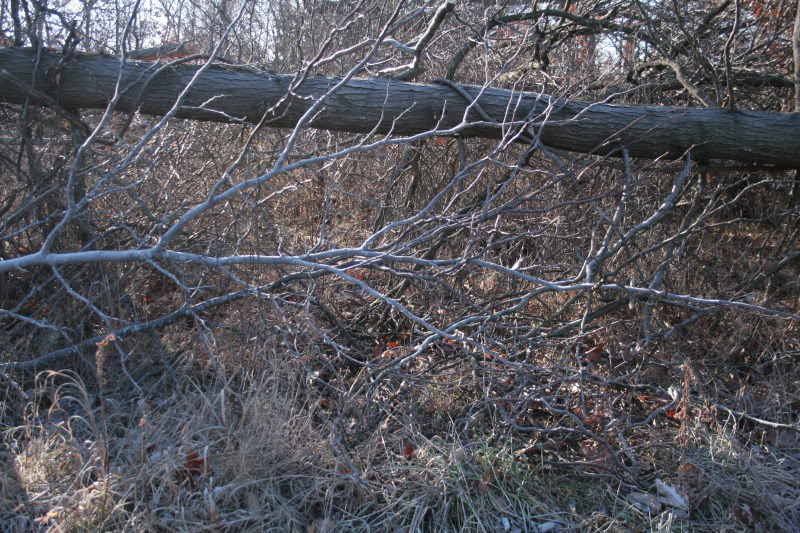
Remember if there are some holes that are difficult to plug, simply cut some tops off from a downed tree and stuff them into the opening. In most cases here that was unnecessary and the big locusts, shingle oaks and elms provided an impenetrable barrier
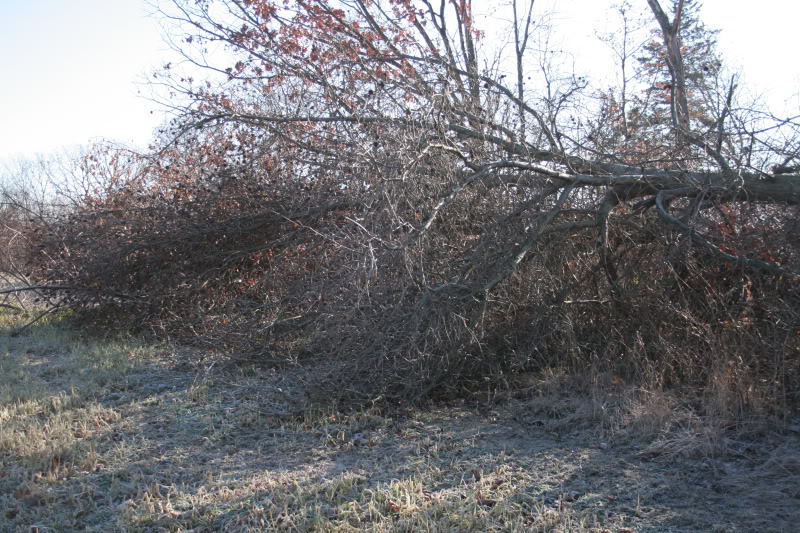

I learned as a young boy that if I created brush piles for rabbits that birds would roost in the brush and leave droppings laden with the seeds of berry producing plants and shrubs such as blackberries, grapes, dogwoods, sumac and a host of other shrubby type plants. In time this would turn it into a living brushpile teeming with wildlife and the same is true with edge feathering
What is now seemingly lifeless tree tops will eventually turn into a living screen that not only blocks runways and insulates deer from the outside but also becomes a plethora of browse and soft mast over time.
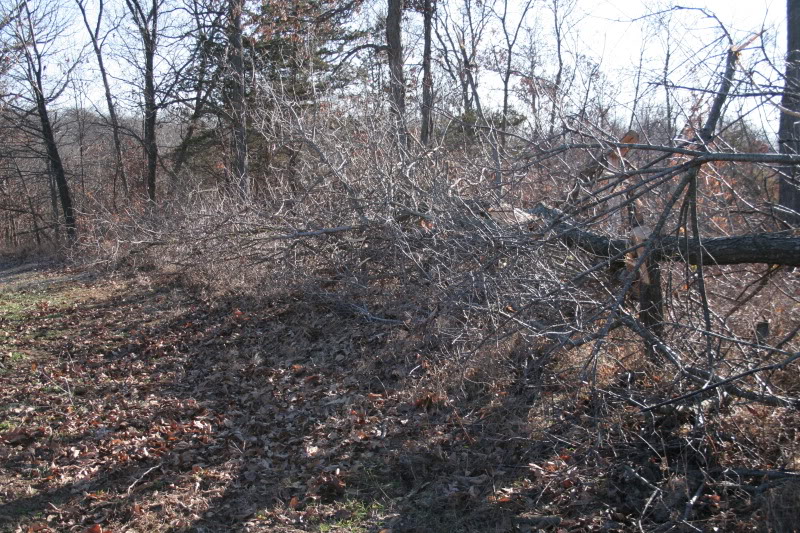
Next year and each subsequent year these downed trees will in essence become a living fence
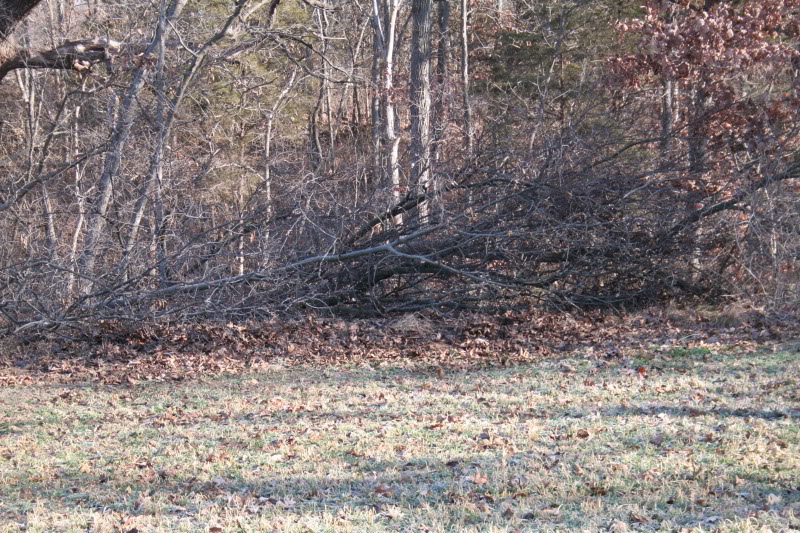
but even now forces deer to use on;y the runways we want them too

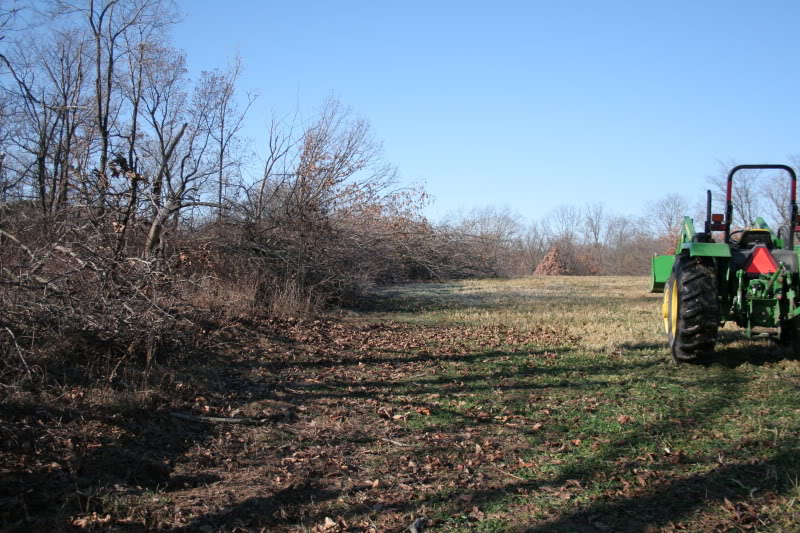
Use caution because trees are heavy and thorns on honey locusts can flatten front tires quickly....I use SLIME in mine along with careful watch that I don't run the tires up on a batch of nasty thorns!

The results are amazing when deer that once came out dozens of runways must now come out...one
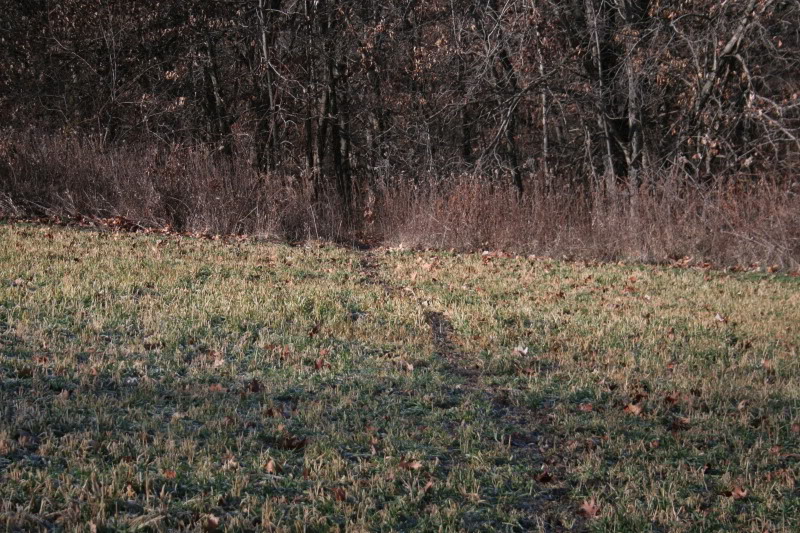
Limiting runways allows us to get far more accurate trail cam surveys as well as encouraging whitetails to bed closer to the centralized feeding area. The feel safe and comfortable and in areas where they are below my line of sight as I walk or drive in, I notice that they simply stay in their beds...sure that they are unseen. Try that when deer are bedded in wide open timber!!
Edge feathering is an extremely effective yet cost effective habitat improvement that almost any landowner can make just remember to explore the Timber Stand Improvement thread first so that you don't destroy valuable mast producing crop trees and then...get busy making your own living fence....
I edge feathered timber a while back but mild west weather kept me from pushing the trees around with the tractor. I always seed around the perimeter with white clover in the fall on new feeding areas and I didn't want to tear up the newly established seeding. A couple days down in the teens allowed me to work on the frozen soil however and I started pushing the trees around parallel with the field edge to both screen and block off multiple runways.
Before

After

Before (note runway)

After...runway blocked with a wall of tree and brush

Remember if there are some holes that are difficult to plug, simply cut some tops off from a downed tree and stuff them into the opening. In most cases here that was unnecessary and the big locusts, shingle oaks and elms provided an impenetrable barrier


I learned as a young boy that if I created brush piles for rabbits that birds would roost in the brush and leave droppings laden with the seeds of berry producing plants and shrubs such as blackberries, grapes, dogwoods, sumac and a host of other shrubby type plants. In time this would turn it into a living brushpile teeming with wildlife and the same is true with edge feathering
What is now seemingly lifeless tree tops will eventually turn into a living screen that not only blocks runways and insulates deer from the outside but also becomes a plethora of browse and soft mast over time.

Next year and each subsequent year these downed trees will in essence become a living fence

but even now forces deer to use on;y the runways we want them too


Use caution because trees are heavy and thorns on honey locusts can flatten front tires quickly....I use SLIME in mine along with careful watch that I don't run the tires up on a batch of nasty thorns!

The results are amazing when deer that once came out dozens of runways must now come out...one

Limiting runways allows us to get far more accurate trail cam surveys as well as encouraging whitetails to bed closer to the centralized feeding area. The feel safe and comfortable and in areas where they are below my line of sight as I walk or drive in, I notice that they simply stay in their beds...sure that they are unseen. Try that when deer are bedded in wide open timber!!
Edge feathering is an extremely effective yet cost effective habitat improvement that almost any landowner can make just remember to explore the Timber Stand Improvement thread first so that you don't destroy valuable mast producing crop trees and then...get busy making your own living fence....
Drop_Tine5214
Member
Dbltree, I was wondering if i could pick your brain about edge feathering in my situation. I have a field on my property where the edges are full of very narrow trees, I would say 1 to 3 inches in diameter. These trees are about 5 to 8 feet tall on average and have very little canopy. They just look like a bunch of pencils stuck in the ground with fuzzy erasers for canopy. They are so close together though that there is little browse on the forest floor. I have started hinge cutting these but they are so small it doesn't seem to do as much for funneling like dropping large trees would. Is there anything I can plant in the tops of these small trees to make an impenetrable thicket like you speak of?
dbltree
Super Moderator
Dbltree, I was wondering if i could pick your brain about edge feathering in my situation. I have a field on my property where the edges are full of very narrow trees, I would say 1 to 3 inches in diameter. These trees are about 5 to 8 feet tall on average and have very little canopy. They just look like a bunch of pencils stuck in the ground with fuzzy erasers for canopy. They are so close together though that there is little browse on the forest floor. I have started hinge cutting these but they are so small it doesn't seem to do as much for funneling like dropping large trees would. Is there anything I can plant in the tops of these small trees to make an impenetrable thicket like you speak of?
I suspect that reducing canopy will encourage growth of blackberries and other shrubby type cover but you can also inter-plant cedars and shrubs into the hinged trees. See the Tree Planting thread for shrub ideas...
Hinging for bedding
When I go on habitat consultations I frequently find situations where people have been told to hinge small areas within their timber but unfortunately not one of those small areas ever has a deer bed in it or even around it. I encourage landowners to hinge large areas leaving small pockets of open areas within the hinged areas. Usually this happens naturally if there are crop trees or conifers but in some cases I run into areas that are 98% weed trees (at least in my view). My definition of a "weed tree" is any variety or species other then oaks, chestnuts or black walnuts but every landowner may have different goals and far different tree species. Every property is unique and every landowner does not necessarily have the same goals so each must decide what is right for them and their personal situation.
All of that said...if holding mature whitetail bucks on your property is you main goal there is one very important thing to remember...the one with the MOST COVER...wins! Cover...is not wide open timber, it is thick brushy habitat where one can not see "feet" into it and cover includes ares of tall NWSG.
The following are pictures of recent hinging I did for a landowner with some pure stands of shagbark hickory with a few locusts and elms scattered throughout.
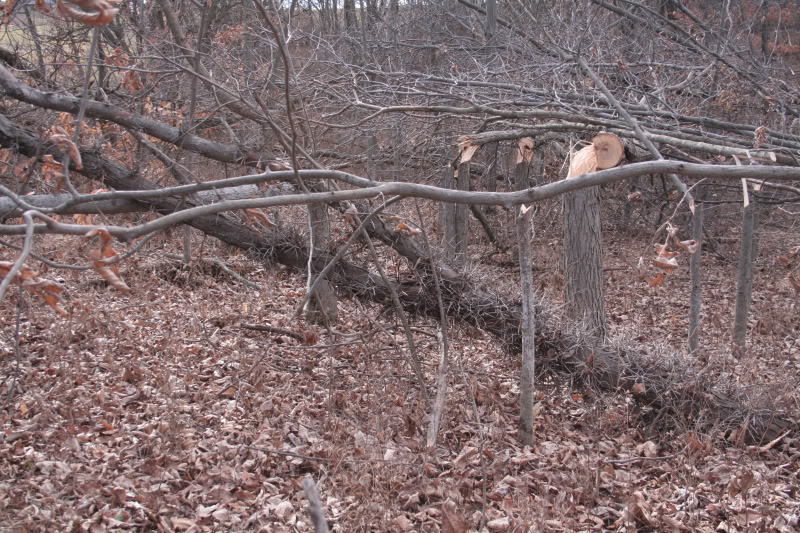
Most hickory's stay hinged pretty well
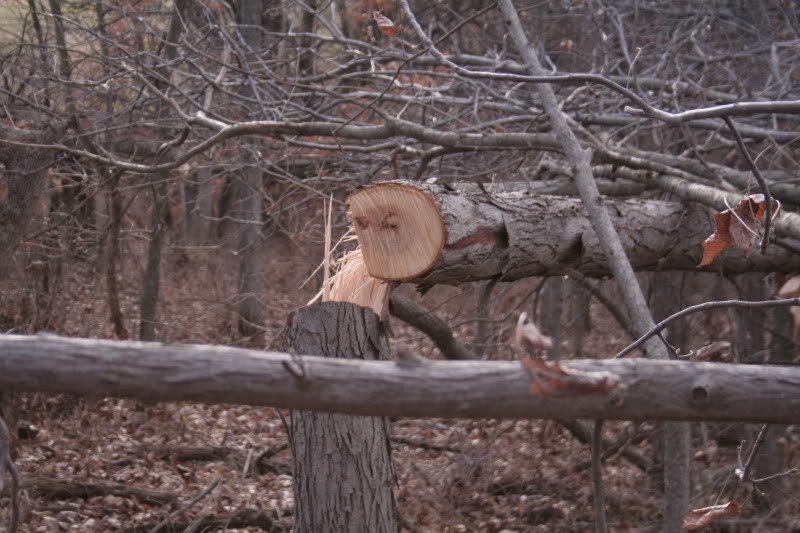
But honey locusts tend to break off

When larger trees fall on smaller ones...

the small trees tend to break off
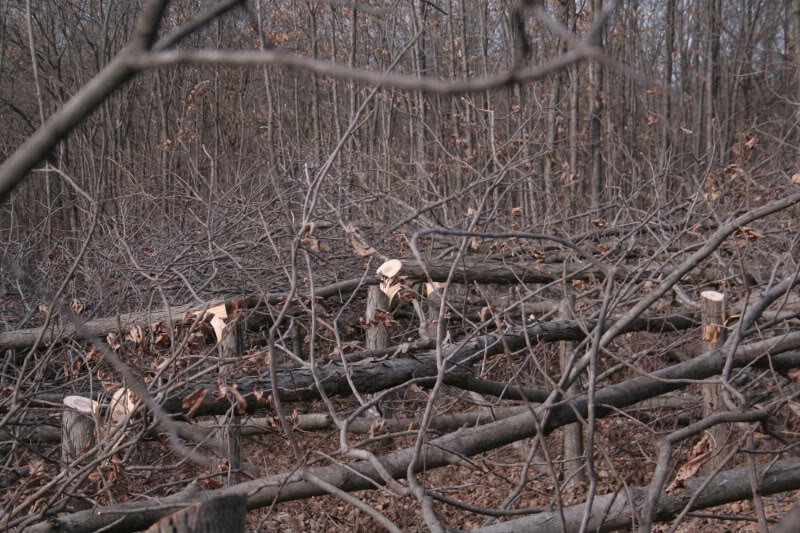
But this is nothing to worry about because the reduced canopy will encourage new growth....compare this to the open timber in the back ground!
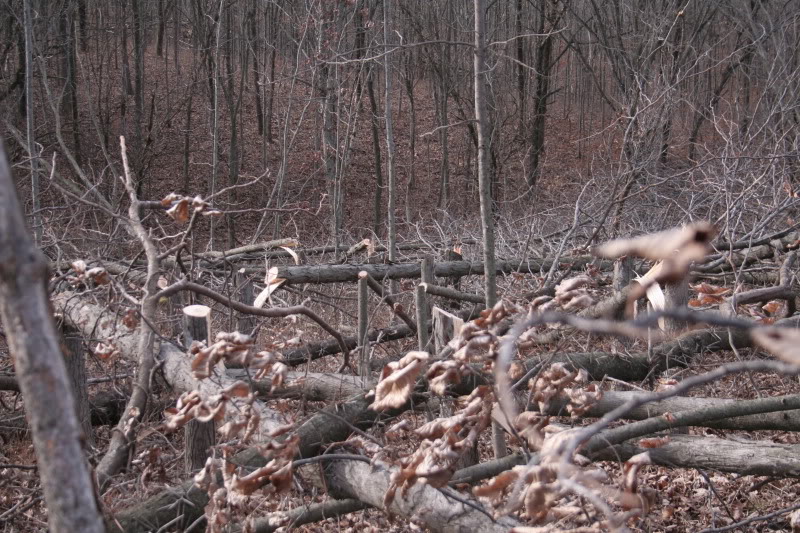
As long as there is a "hinge" or connecting bark most hinged trees will remain alive for a number of years, although not all will survive long term simply because new growth will rise up thru the downed trees and the resulting canopy will kill the hinged trees.
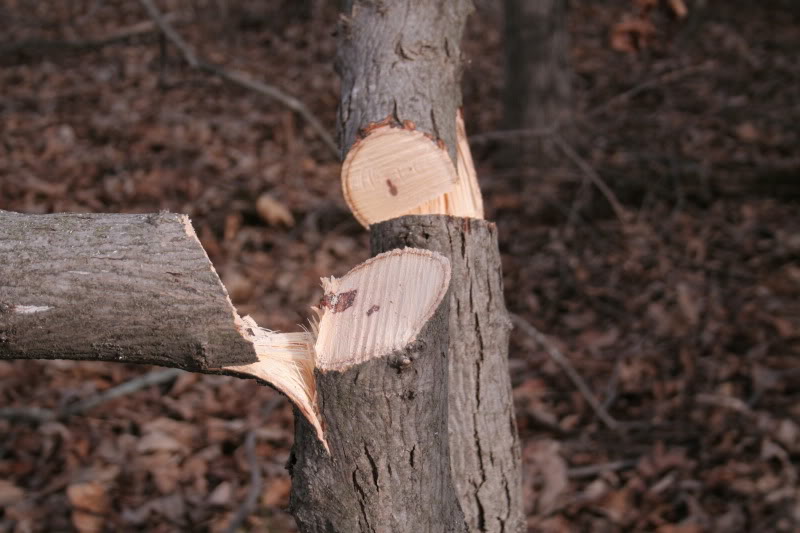
Managing ones timber resources then is an ongoing, never ending job
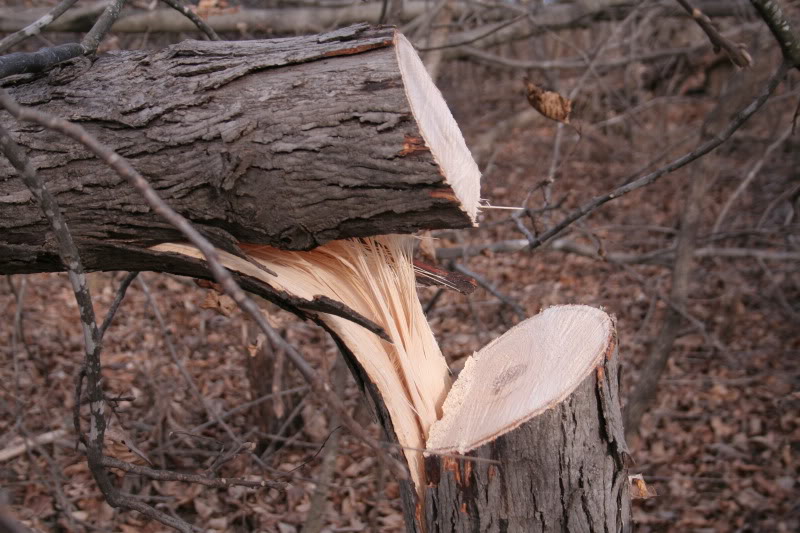
So while I encourage you to hinge relatively large areas, do your entire timber area in a succession over a number of years
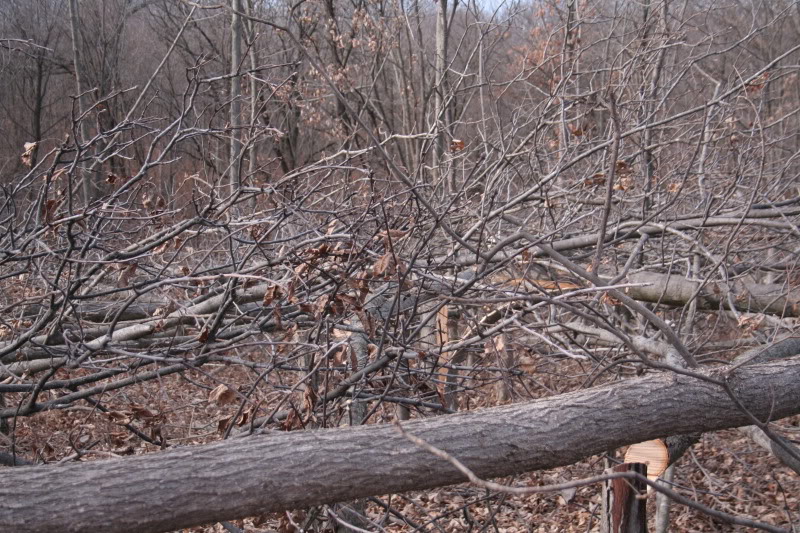
Eventually you'll find yourself staring to work in the original areas once again...5-10 years later

The downed trees will make instant cover

and hinging at roughly 4' high will provide plenty of ground cover

It's a mess...a beautiful mess that will be one of the most important habitat improvements most landowners will ever make.
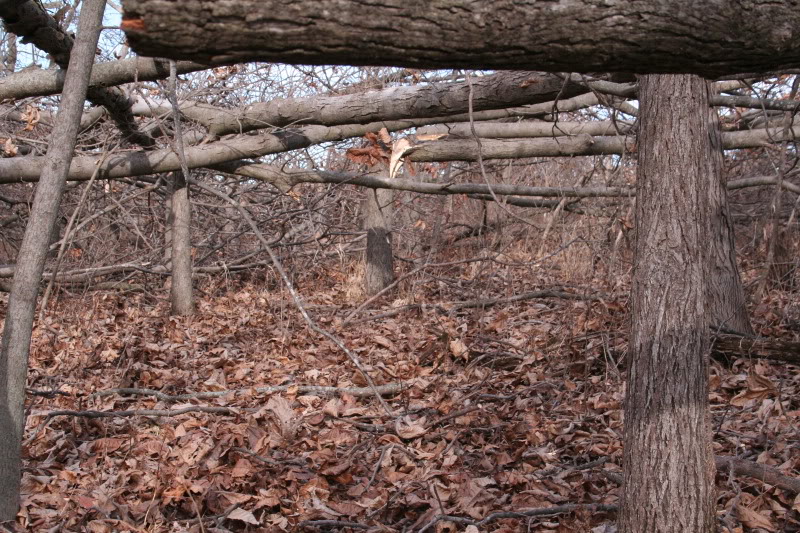
Instant screening and an overnight ready food supply of fresh browse is whitetail heaven!

Remember to do the edge as well and push trees around to block off extra runways and further screen and insulate deer from the outside.
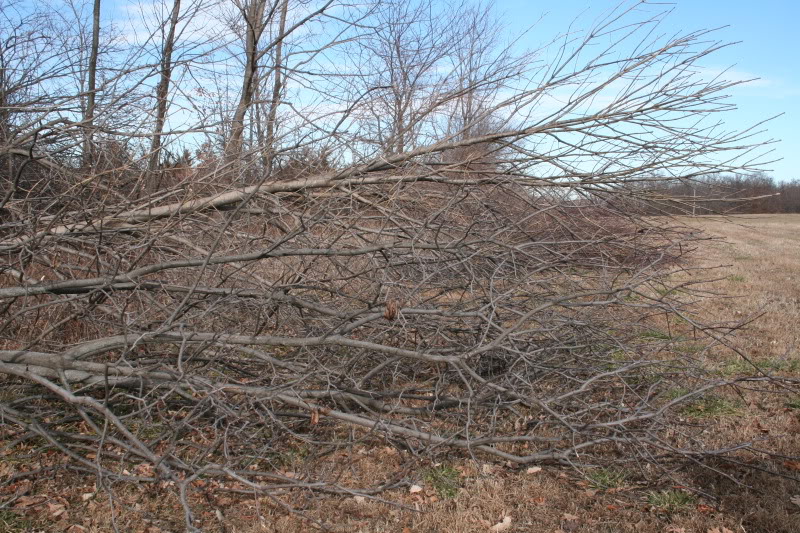
If you desire success....focus on the cover first and the feed second....unfortunately people make it all about the food sources and in doing so...they lose! Lot's of thick natural cover will guarantee you have lot's of whitetails.... lot's of food without premium cover means you'll likely be frustrated and disappointed.
If you succeed or fail is up to you but...if your reading this you have the now have the tools to successfully reach your goals of holding and harvesting mature whitetails on your property.... :way:
Daver
PMA Member
I suspect that reducing canopy will encourage growth of blackberries and other shrubby type cover but you can also inter-plant cedars and shrubs into the hinged trees.
If you desire success....focus on the cover first and the feed second....unfortunately people make it all about the food sources and in doing so...they lose! Lot's of thick natural cover will guarantee you have lot's of whitetails.... lot's of food without premium cover means you'll likely be frustrated and disappointed.
I just want to emphasize what Paul is saying here from my own experience. Long story short, on our place this year our food supply is limited as the drought hurt our food plot program pretty bad. BUT...after doing TSI a few years ago our cover in the timber is way better than before and we have good numbers of deer in our timber at this time of the year that I am sure is due to the much improved browse and understory.
Say 5 years ago, pre-TSI, our timber was pretty open and there were few deer in the timber this time of the year, now it is the opposite AND our TSI work pales in comparison to what Paul accomplishes with the hinge cutting he illustrates here. In other words, we could do more hinging and make things better yet.
Cover, cover, cover...timber management is a super key thing, the info in this thread is potentially the most important thing you can do to help your place.
Crimson Arrows
Well-Known Member
Talk about timing....
Three of my closest friends helped me all day Sunday and we got about 4 acres done in an area that was 80% ironwood and hickory. It looks like a jungle now and is a little un-nerving, but was amazing to see the changes before our eyes. Where once you could see 100 yards, now was down to 20 :0
We created two major funnels that both lead past a great stand site.
You had mentioned above about "succession". Since the majority of these draws is ironwood and hickory, would it be ok to do them all this winter, save select pockets say 40 yards across.
Or be best to leave the IW and SBH for next winter in some areas. I have the help now, but is it a "bad" idea to do them all now?
The other side of the property is more valuable timber, so there it is TSI first and selected areas for hinging on ridge tops. But where we are working is all IW and hickories, which could make each draw that borders ag fields incredible bedding and holding zones.
One last question, how do turkeys adapt to these changes? I would think would help them for nesting and cover, as long as they have big trees to roost and fields to feed and strut.
Three of my closest friends helped me all day Sunday and we got about 4 acres done in an area that was 80% ironwood and hickory. It looks like a jungle now and is a little un-nerving, but was amazing to see the changes before our eyes. Where once you could see 100 yards, now was down to 20 :0
We created two major funnels that both lead past a great stand site.
You had mentioned above about "succession". Since the majority of these draws is ironwood and hickory, would it be ok to do them all this winter, save select pockets say 40 yards across.
Or be best to leave the IW and SBH for next winter in some areas. I have the help now, but is it a "bad" idea to do them all now?
The other side of the property is more valuable timber, so there it is TSI first and selected areas for hinging on ridge tops. But where we are working is all IW and hickories, which could make each draw that borders ag fields incredible bedding and holding zones.
One last question, how do turkeys adapt to these changes? I would think would help them for nesting and cover, as long as they have big trees to roost and fields to feed and strut.
SEIowaDeerslayer
Well-Known Member
One last question, how do turkeys adapt to these changes? I would think would help them for nesting and cover, as long as they have big trees to roost and fields to feed and strut.
We did our first hinge cuts on our property last winter and the hens loved them for nesting. We had several nesting hens on our property last year where as before we had none. We left a few areas of timber still open for gobblers to strut in, but they mostly prefer the fields to do that anyways.
Crimson Arrows
Well-Known Member
Thanks Brock! Just the info I was looking for.
Daver
PMA Member
One last question, how do turkeys adapt to these changes? I would think would help them for nesting and cover, as long as they have big trees to roost and fields to feed and strut.
Brushy timber = turkeys like!
Also, you mentioned TSI and assuming you have oaks to "release", you will see a positive there too as more acorns = more turks too.
Crimson Arrows
Well-Known Member
Thanks Daver. That has been my only fear in pushing turkeys out but sounds like it will be a benefit 
risto2351
Well-Known Member
Brushy timber = turkeys like!
I believe what you guys are saying but it seems like I see more turkeys in areas that I can see along ways in, than in the really brushy areas?
